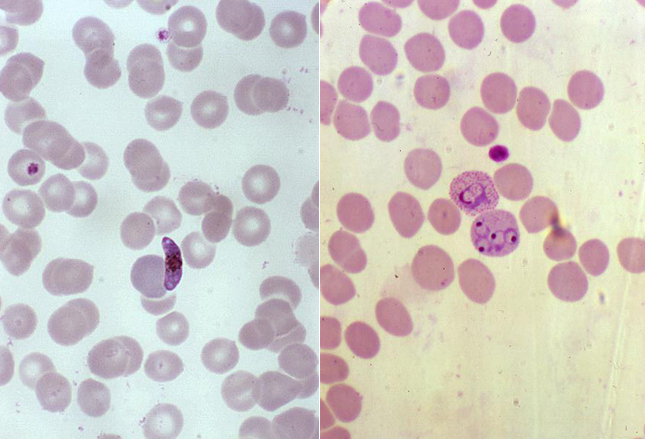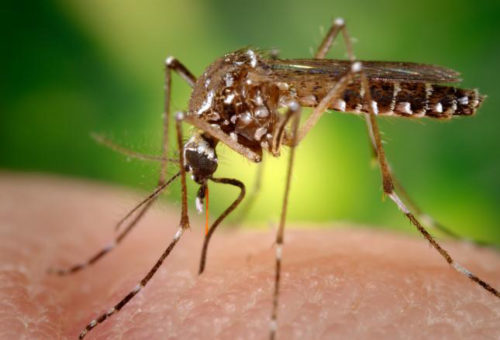Mosquito Illnesses – Zika, Dengue and Others
For the first time in a long time that I can remember, the dislike of mosquitos has taken on an entirely new life this summer. Most certainly due to all the medical news about the mosquito illnesses and Zika; but, there are other diseases mosquitos harbor too that we can’t just rely on “citrus smells” and “bug zappers” to defeat.
Bite from female Aedes aegypti mosquito – spreader of disease
At best they are annoying and infuriating, at worst… deadly.
They get called “stupid” a lot during our wild, flailing attempts to ward them off; but, they’re not so stupid that they are easy to smash or ward off. In fact they have highly-refined sensory and locomotor systems built in to be successful at attacking humans (well, we’re not the only targets – it just feels like it).
Mosquitos – NOT Merely An Annoyance
Every year more humans die from mosquito bites than from bites of all other animals combined! More than 1 Million people die from mosquito injected diseases each year! And, HUNDREDS of million people suffer damage and illness short of dying! I’m running out of exclamation points!
Of the 700 MILLION people yearly infected by the suckers, almost all of them occur in developing countries.
Mosquitos Basics
If you ever get to wondering whether that miserable thing buzzing in your ear is a mosquito or some other creature, just squint your eyes and see if it has a long “proboscis” (a mouth tube) and if it has scales on its body.

There are, conservatively speaking, over 3500 species of mosquitos but only several hundred are capable of transmitting disease and only a handful of them actually do it (that we know of) – and gee I thought we were in for real trouble.
To call them “capable survivors” is like calling Attila the Hun a “real meanie” – those suckers are deliberately designed by engineers to plague mankind to ruin! Their eggs in stagnant water turn to larvae designed to scrape every living nutrient into their reproduction.
Unique to any other pupae, their mouthparts are snorkels allowing them to submerge in danger and there’s wax on hair tips allowing thriving in dirty and hypoxic water.
They beat their wings up to 500 times per second and are unbelievable at airborne maneuvers; they locate prey by specialized odor and CO2 receptors on antennae and palps. Only Females are blood-feeders!
Their feeding “utinsils” read with words like: uniquely-specialized, piercingly-thin and wiry, blade-like, carving, hackers, slicers, two-way pumping of blood and saliva, – absolutely none of which seems like it ought to be “allowed.” It even has “venoms” that knock out bodily defenses by preventing blood clotting, platelet aggregation, host immunity, inflammation and other defenses.
And the thing is: their dirty saliva can be full of viruses and other pathogens. And if that’s not enough, even their diseases are insidious to the point that we know that infected mosquitoes (with the viruses) actually spend more time searching and poking around to find a blood vessel than noninfected mosquitoes do – thereby enhancing chances of transmitting the disease!
At best a mosquito bite makes a raised, itchy bump on your skin surrounded by a red flare at the base. Undisturbed it disappears in a couple days; but, scratched to death, it enlarges, breaks down skin and makes susceptible to secondary infections. At worst? Well, I’ll tell you.
Aedes Aegypti

We’ve said that hundreds of mosquitoes feed on human blood but only two species, Aedes Aegypti and Aedes albopictus, cause the transmission of numerous arboviruses.
Notice the photo on the right is A aegypti full of blood (making it a female) and, if it was diseased, that unlucky arm at the end of its “sucker” could now be infected with yellow fever, dengue fever, Zika virus, Chikungunya virus or any of a number other pathogens. Despite it’s name it was “designed” in Africa.
A albopictus however, hails from Asia where it has earned the name: “Asian tiger mosquito.” Both of them, as you have heard over and over, now make themselves home all over the globe.
Not to be outdone, A albopictus also transmits dengue fever, Zika virus and Chikungunya.
Mosquito Illnesses
Dengue fever

Lest you get the ridiculous idea that things like Dengue fever (bone-break fever) are ONLY “over there”, here is 15 year old Hunt Cramer who got ill on the plane ride home from Thailand where he had just spent a month doing church-related humanitarian service. His fever spiked, he began babbling and was so weak he could barely make the several plane transfers culminating in an ambulance ride to a specialty hospital in Vermont.
Until recently completely untreatable and unpreventable (except anti-mosquito efforts), bone-break fever or Dengue Hemorrhagic Fever, affects 390 MILLION people world-wide each year! Only recently, a vaccine has been developed which may prove to be a god-send if it can be distributed to where it’s needed.
If the boy had been bitten by a mosquito at any time during his many hours of travel home, in fact at any time during his active illness, we now would have active colonies of diseased mosquitos breeding all along his travel path.
Its symptoms are excruciating with high unrelenting fever, intense headache, severe eye pain, joint pain, nosebleeds, rash and low white blood cell counts. And even though it’s not typically fatal, it can lead to life-threatening dengue hemorrhagic fever or “Dengue Shock Syndrome.”
Zika virus disease
The Zika virus that’s been getting all the press recently isn’t new. In fact it was detected in 1947, almost 70 years ago, in Ugandan monkeys and known to be transmitted by – you guessed it: Aedes mosquitos! It’s just taken that long to slowly move eastward and into the Americas.
The issue is that as it has migrated in location, the virus of the disease it causes has transmuted too. It went from causing “dengue-like” symptoms with back pain, fever, rash, joint pains and headaches to adding neurologic and autoimmune complications and recently adding Guillain-Barre syndrome too. Surprisingly, in all the laboratory double-checking, we know that large numbers of those infected with the disease don’t have any symptoms at all!

In May of 2015 Zika virus made inroads into the United States and along with that, Brazilian health departments documented that the number of infants born microcephalic literally skyrocketed to 20 times previous numbers. That is different than in previous outbreaks so the disease may have mutated again.
That last fact has triggered some controversy. Some think the microcephaly is linked to the pyriproxyfen they had introduced into the drinking water (!?!) in the areas most affected by microcephaly.
Others think the spike in microcephaly is merely due to an “increased awareness” of the association.
Pyriproxyfen is a “sister” to an insect hormone which keeps immature insects from undergoing metamorphosis – you think there could possibly be a connection with human brains developing as well? Not a real stretch of the imagination.
The thing is that right now (2016) we are at the leading edge of discovery in this area and things are guaranteed to change over the next couple years. There is currently travel advisory against pregnant women traveling to affected areas.
And, if that weren’t enough, we’ve now confirmed sexual transmission of the Zika virus so authorities believe that this mode may be more common than previously thought.
All we’ve got in our medical bags for this disease is supportive treatment while the virus runs its course and lots advice for pregnant women to avoid mosquito areas and for men to wear condoms.
Yellow fever

Yellow Fever joins Zika and Dengue as one of the mosquito illnesses in the genus Flavivirus along with West Nile. This one is transmitted from mother mosquito to her infants which even explodes its mass epidemic ability.
It historically caused tremendous epidemics and death – so much so sailors even had a “yellow jack” (the name they called it) signal flag they could run up the mast to designate they had the disease on board (see photo inset). It still infects over 200,000 annually producing 30,000 deaths! An outbreak in Angola that began in Dec 2015 is still infecting the population today (Jun 2016) and has killed close to 200 so far.
Three to six days after a mosquito bite the infected develops fever, chills, muscle aches and back pain, headache, lack of hunger, nausea and vomiting; which, if they’re lucky only lasts a few days. An unlucky 15%, however, enter a more toxic jaundice, abdominal pain and vomiting phase that doesn’t end well for half of them.
Fifty percent hemorrhage from the eyes, nose, mouth or stomach and their kidney function deteriorates before they die within 2 weeks. That does leave the remaining 50% to recover; but, still!
And the thing is, our treatment is merely to mitigate symptoms and support them through their illness. That’s all we can do. And the sad part is that although we now have a vaccine to prevent the disease, logistical difficulties in developing countries (where they need it the most) usually prevent the populace from reaching the minimum effective threshold of immunity – one shot isn’t enough, it takes boosters.
Yellow fever spread from Africa to the Americas via the slave trade. In 1864, a bioterrorist plotted the spread of yellow fever via clothing and blankets, targeting Abraham Lincoln and northern cities in the United States; but the scheme was foiled by a disgruntled fellow conspirator. Nevertheless, it would ultimately have been unsuccessful due to a complete misunderstanding of how the disease is spread.
Chikungunya virus disease

I have to confess that although Chikungunya disease was discovered in 1952 I seemed to have missed that one in medical school texts. We never saw a case, of course, not being in Tanzania where it was first noted. The name means: “that which bends up” after the crippling joint pain that it causes.
In 2005 the virus mutated and began to spread from tropical climates into temperate climates because it now can be carried by A albopictus and not just the Aegyptus mosquitos. In 2013 a Caribbean epidemic was triggered and by 2015 1.4 Million cases have been reported in the US and Latin America. The “reservoirs” of the disease are in birds, monkeys, cattle and rodents.
The disease begins with a mosquito bite of course then sudden onset of fever, morbilliform rash, headache, myalgia and contorted posture due to crippling joint pain.
Although most of those infected recover in about a week, the joint pain not-so-much. It often persists for months or years and rare cases also develop neurological disorders (eg encephalitis). Most deaths occur in the elderly, very young and immunocompromised individuals and, like in the other diseases, treatment is only supportive.
Japanese encephalitis

Not to be outdone, two other mosquito species (other than the two we’ve already mentioned) show how virulent they can be and are the vectors for Japanese Encephalitis wich plagues mostly the countries of Indonesia.
Culex tritaeniorhynchus and Culex vishnui are also in the genus Flavivirus but thrive best in the tropical climate around the Bay of Bengal, South China Sea and Philippine sea but touch into Australia as well, killing and maiming pigs and wading birds with the occasional horse and cow and human thrown in.
The photo shows a child in India with the disease exhibiting the characteristic opisthotnic posture with is due to the tenderness of the inflamed lining of the brain which is infected.
Mild infections (if an infection of the lining of the brain can be called “mild”) begin with fever and headache (and some are without symptoms entirely). About 1 in 250 however go on to high fever, severe headache, stiff neck, disorientation, coma, seizures, spastic paralysis… and ultimately death – about 13-20 thousand per year.
The serious cases are primarily children and up to 30% of survivors are left with some kind of permanent neurological or psychiatric damage. The endemic countries have begun to note a cycle of major outbreak every 2 – 15 years.
Like the other mosquito borne viral diseases we’ve mentioned, there is NO treatment for the disease once it’s been contracted; however, unlike most previous diseases we’ve mentioned, there are several types of preventive vaccines in use.
Malaria

If you want to avoid getting bit by the Anopheles mosquito you need to find a job in Antarctica, the only continent where A gambiae doesn’t reside. Among mosquitoes this genus are exceptionally detrimental to humans – they carry MALARIA.
There are about 460 species of Anopheles and only a few dozen transmit malaria but the others carry things like canine heartworm, filiariasis and o’nyong’nyong fever.
Malaria is the “big one” killing 450 thousand people a year, mostly children; but, close to 214 MILLION people contracted malaria in 2015!
It’s a parasite, not a virus like the others we’ve already listed – Plasmodium falciparum or Plasmodium vivax. Female Anopheles gambiae mosquitos then carry the disease back and forth between human and other hosts where it does the dirty work.
The Plasmodia parasites have a complex life cycle, partly in an insect host and partly in a human host. From an infected insect’s saliva they invade the mammal’s liver, multiply, differentiate into blood forms, flood the blood-stream, infect red blood cells, damage them and multiply to infect more blood cells.
During the process the red-cells become sticky and bind to the walls of blood vessels – not good anywhere but in the brain it becomes critical! While in the blood, the parasites can be “sucked up” by more mosquitos and start the cycle all over again.

The initial symptoms of Malaria may be rapid or delayed from the initial mosquito bite; but, is flu-like and difficult to distinguish from a lot of other conditions. As the disease progresses, fever and chills can become quite severe progressing to jaundice and spells of sweating. There also can be relapses.
Severe forms of the disease can include neurologic abnormalities, severe anemia, blood in the urine, respiratory distress, low blood pressure, acute kidney failure, acidosis and low blood sugar.
Malaria is the only one of the diseases we’ve mention where we have a viable treatment with antimalarial medications. It has been eradicated in many countries although the risk of reinfestation remains as long as their is a vector mosquito.
We still have no licensed vaccine although we do have some pharmaceutical compounds to take prophylactically.
Other Mosquito-Borne Illnesses
This post is already quite long so I’ll only mention a few other mosquito born illnesses. Heartworm – dogs, cats and some humans; West Nile Virus – responsible for epidemics in recent years; Eastern and Western Equine Encephalitis – horses; and, St. Louis Encephalitis – humans.
Prevention – Mosquito Illnesses
Prevention of Mosquito Bites
Wide-spread mosquito abatement measures are critical to the eradication and prevention of mosquito-borne diseases because personal protection chemicals are only intermittently and incompletely effective.

Additionally, much of the poorly-attended ground where water can run or pool is owned by governments. Ditches, ponds, pools all must be cleaned, dried and “husbanded” continually to prevent stagnation and becoming breeding grounds for mosquitos.
Personal patrols and correction of even small volumes of water – ditches, buckets, empty cups, old tires, tarp folds, birdbaths and derelict garbage cans (bins) are all nurseries for huge crops of mosquito larvae.
Dig channels to pool standing water into a single deep place where the deeper, more-permanent water will attract diving beetles, backswimmers, dragonflies, and other aquatic predators that deal very efficiently with prey that is obliged to come up for air.
On your person, wear light-colored clothing covering as much exposed skin as possible and apply DEET (N,N-diethyl-meta-toluamide)–containing insect repellents to vulnerable areas. Sleep under mosquito nets, and don a net hood in areas where mosquitoes teem.
Eat generous helpings of the most pungent local foods. Be mindful of your immediate surroundings and, remember, mosquitoes are present during the day and night. Your ears will often detect a mosquito before it is close enough to bite you.
Vaccine Development
What we’re looking for is a strong response from the immune system, long-term protection, few doses and no side effects – not that easy or simple.
Zika: Scientists in Canada, Brazil and the US NIH have already started work on a Zika vaccine, and might have a few substances ready for research trials before the end of 2016; however, regulatory approval will obviously take many years. Until then it could – potentially – be used in public health emergencies before approved.
Yellow Fever: A “weakened” live vaccine is already available since 1938 – and highly successful. 35 of the 44 countries at risk for yellow fever have already incorporated the vaccine into infant immunization programs.
The yellow fever vaccine, developed in 1938, has been highly successful at protecting against the virus, which can cause bleeding, jaundice, kidney and liver failure and, ultimately, death. Of the 44 countries at risk of yellow fever in Africa and the Americas, 35 have incorporated Yellow Fever vaccines into infant immunization programs.
It is a live vaccine, in which a “weakened” virus induces a protective immune response against subsequent infection.
Dengue: Vaccine development is close with clinical trials underway. A vaccine has been licensed for use but only in Mexico. The field has been littered with promising-but-failed vaccines for Dengue Fever which could not protect against the major strains but there is hope that one will be available in the next years.
Chikungunya: The dramatic expansion of this disease around the world has now led to increased research on a vaccine for this disease.
Chikungunya virus has recently emerged as a serious human pathogen, causing fever and excruciating pain in the joints that can last months. A number of vaccines are entering clinical trials, early successes have been reported but we are still several years away from an approved vaccine.
Malaria: There are already medications we use to prophylactically prevent contracting Malaria. Vaccines however have been elusive for decades! One vaccine has recently been successful for some patient groups but only gives partial protection. The debate is still on over its value given it’s limited success; but, with more than 400,000 deaths a year, any success is good success.
7 Posts in Bug Bites (bugbites) Series
- Part 2 - 33 things about bug bites: fleas, bed bugs, spiders, Zika, Dengue and Ehrlichiosis. – 28 Mar 2018
- Part 1 - 33 things about bug bites: Ants, Chiggers, Ticks – 23 Mar 2018
- Ticks and Fleas – 11 Dec 2016
- Bed bugs, Mites and Lice – 7 Dec 2016
- Mosquitos and their illnesses – 23 Jun 2016
- Scabies is coming back! – 27 Oct 2014
- Bug Bites Series: Intro/Index – 15 Oct 2014

